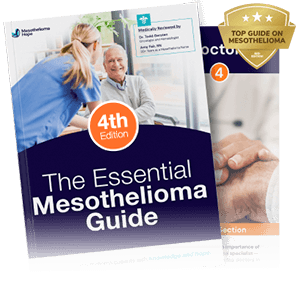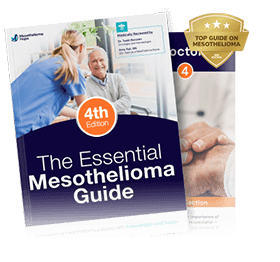In most cases, mesothelioma, a rare cancer that’s caused by asbestos, is diagnosed in people over the age of 65. This is because it often takes 10-50 years for this cancer to develop after asbestos exposure.
However, mesothelioma can also affect children and young adults through:
- Direct exposure, like with asbestos-contaminated talcum powder or asbestos materials in the home
- Secondhand exposure, such as when a parent brings home asbestos fibers on their work clothes
Because it’s so rare for children and young adults to develop mesothelioma, less research has been done on these cases. In fact, data on clinical characteristics, treatment strategies, and survival outcomes of mesothelioma in patients under the age of 40 had not even been formally analyzed — until recently.
In February 2024, the Journal of Pediatric Surgery published a review of data on mesothelioma in young adults and children, comparing the most common types of mesothelioma they would be diagnosed with, the treatments they received, and their life expectancy.
Learn what the research uncovered below.
Reviewing Mesothelioma in Young Age Patients
Researchers performed a retrospective review of mesothelioma in children and young adults by consulting the National Cancer Database (NCDB) for pediatric patients and young adults between the years of 2004 to 2019.
This review is one of the largest reports investigating mesothelioma in individuals under 40 years of age.
A total of 570 patients were studied, including:
- 46 pediatric patients (age 0-21 years)
- 524 young adults (age 22-39)
The results demonstrate distinct and important differences to consider when doctors are assessing symptoms and beginning to explore a diagnosis. The results may also help doctors develop effective treatment options for patients at any age.
Get help understanding the symptoms, diagnostic tests, and best treatment options for your case in our Free Mesothelioma Guide.
Types of Mesothelioma Affecting Young Adults and Children
There are four different types of mesothelioma, each of which develops in a different location of the body. The study specifically reviewed data related to the two most common types of mesothelioma, pleural and peritoneal.
Of the 570 patients studied:
- 363 had peritoneal mesothelioma, which develops in the lining of the abdomen
- 207 had pleural mesothelioma, which develops in the lining of the lung
The data suggests that peritoneal mesothelioma is more common among younger patients, but it’s not clear why. Similar to data for those above the age of 40, the study found peritoneal mesothelioma was more common among young women than men, accounting for 229 cases.
Young adults made up the majority of these cases, with children accounting for less than 10% of peritoneal cases and around 5% of pleural cases.
Treating Mesothelioma at a Young Age
Mesothelioma has an average prognosis (expected health outcome) of 12-21 months, but patients diagnosed early can live longer since they’re often able to withstand more intensive treatments.
Similar to the data of older patients, the young women in this study also had a better prognosis than men.
Thankfully, because each of the patients in this study were diagnosed so young, they responded well to treatment and had much higher life expectancy than older patients.
While surgery to remove the cancer led to longer survival overall, pre-surgery chemotherapy and radiation were found to decrease overall survival. These findings could help doctors more accurately determine the best treatment options for younger mesothelioma patients.
Peritoneal Mesothelioma Treatment Results for Young Patients
The young peritoneal mesothelioma patients in this study received surgery and chemotherapy, which are standard treatment approaches recommended by the European Cooperative Study Group for Pediatric Rare Tumors.
Of the 363 peritoneal mesothelioma patients:
- 206 had radical surgery, removing the tumor and surrounding tissue that may contain cancerous cells
- 241 received chemotherapy
Patients with peritoneal mesothelioma had a better outcome, regardless of age group. In fact, young peritoneal patients survived an average of 125 months, a life expectancy more than double that of adults with this cancer.
Pleural Mesothelioma Treatment Results for Young Patients
Pleural mesothelioma is historically more difficult to treat than peritoneal mesothelioma, but because of their young age, the patients in this study responded well to treatment.
Of the 207 pleural mesothelioma patients:
- 51 had radical surgery to remove visible tumors
- 127 received chemotherapy treatment
The combination of these treatments helped young pleural mesothelioma patients survive an average of 69 months. This is a much higher life expectancy compared to older patients, who typically live 18 months on average after a pleural mesothelioma diagnosis.
Get Help Understanding Mesothelioma and Your Treatment Options
Mesothelioma symptoms are easy to miss, and doctors may not suspect young people, especially young women, to develop this cancer. Regardless of your age or gender, Mesothelioma Hope can help you understand mesothelioma symptoms, diagnostic tests, and treatment options.
Because mesothelioma is so rare and even rarer for young people, it is crucial to find a doctor experienced in diagnosing and treating this cancer. Our team can connect you with trusted mesothelioma specialists near you so you can get an accurate second opinion.
Learn more about how we can help by getting a Free Mesothelioma Guide or calling our Patient Advocates at (866) 608-8933.











